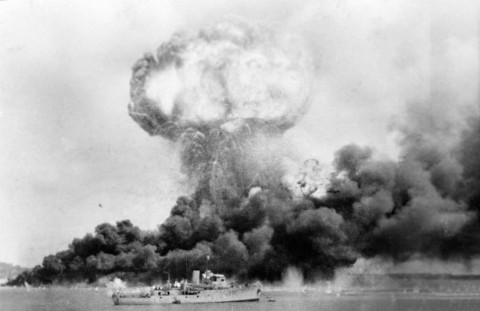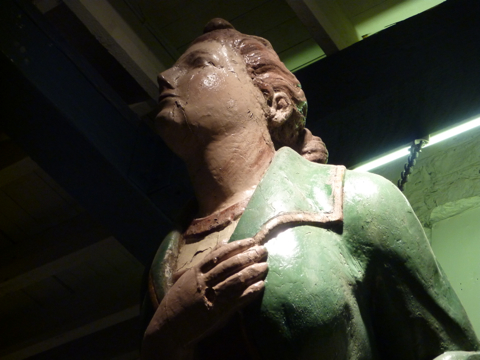Thirteen days ago, it was the 70th anniversary of the bombing of Darwin, the first and most devastating Japanese air raid on Australia. In fact, there were two air raids on 19 February 1942: one from the same carrier task force which had attacked Pearl Harbor a little over two months previously, and another later in the day by land-based bombers from recently-occupied airfields in the Netherlands East Indies. Around 250 people were killed, mostly from the military since two-thirds of its pre-war population of 5800 had already been evacuated. Ten ships were sunk, including an American destroyer, the USS Peary. The RAAF station was hard hit too. Electricity and water services were cut (though soon restored); port and oil facilities severely damaged (shown above).
Despite Darwin’s status as Australia’s northern gateway (it was a prewar QANTAS staging post on the Singapore route) it was poorly defended. There were few anti-aircraft guns, no radars, and only two RAAF squadrons, one of general purpose Wirraways and the other of Hudson light bombers. Only the accidental presence of a squadron of American P-40s returning from an abortive flight to Timor allowed any sort of defence to be mounted in the air. Of the ten P-40s, five were out of fuel and had to land; four were shot down; one claimed two Val dive bombers. Anti-aircraft accounted for another Val and two Zeroes. Wing Commander Archibald Tindal was killed manning a Lewis gun against the enemy; RAAF Tindal is named after him.
Morale in the town held up reasonably well until after the second raid, when rumours began to circulate that a Japanese invasion was imminent. Perhaps not surprisingly: Fortress Singapore had fallen only four days earlier, and the Indonesian archipelago to the north was now coming under Japanese control. An exodus south began, accelerated by a belief that martial law had been imposed. (In fact military control did not start for another two days; it remained until the end of the war.) Civil society broke down as government and businesses shut up shop. People drove (where they could procure petrol), hitched rides (nine people clung to the side of a council grader), or simply walked along the road to Adelaide River, a small township south of Darwin. There were ugly scenes when a train was laid on to evacuate women and children, and men turned up clamouring to be taken too. The unseemly nature of the evacuation gave rise to its sardonic monicker, the Adelaide River Stakes.
Such things might be expected from undisciplined civilians. But the military was little better. Looting of abandoned private houses and business premises went on long after the bombers had left. Some of the remaining civilians took part, but so did Army personnel, including members of the Provost Corps who had been brought in to maintain order. There was also substantial desertion, with the RAAF faring particularly poorly: even four days afterwards, a muster found 278 RAAF personnel absent without leave. The commander of the RAAF station did order his airmen to remove to ‘half a mile’ down the road and then ‘half a mile’ into the bush, but that can’t explain where the AWLs ended up: some to Batchelor, a distance of 61 miles (100 km) from Darwin; others to Adelaide River, 70 miles; one to Daly Waters, about 385 miles; and one man, infamously, made it all the way to Melbourne, around 1950 miles as the crow (or bomber) flies. [Additional: see below for his side of the story.] That’s about the same distance London is from Volgograd (formerly Stalingrad). It took him thirteen days to make it here, which means today is the seventieth anniversary of the end of the Adelaide River Stakes, which is why I’m writing this post today (and not because I forgot to thirteen days ago). For some reason I can’t seem to find any reports of speeches and ceremonies to mark this historic occasion; and only one recent press report even mentions the Adelaide River Stakes. It’s the race that never stops a nation.
Sources: Wikipedia for the photo. For the attack and desertions: the official history, Douglas Gillson, Royal Australian Air Force 1939-42 (Canberra: Australian War Memorial, 1962) and the officially supported history, Alan Stephens, The Royal Australian Air Force (South Melbourne: Oxford University Press, 2001). For everything else: the report of the Lowe Commission of Inquiry; Timothy Hall, Darwin 1942: Australia’s Darkest Hour (Sydney: Methuen Australia, 1980); Peter Grose, An Awkward Truth: The Bombing of Darwin, February 1942 (Crows Nest: Allen & Unwin, 2009).
![]() This work is licensed under a Creative Commons Attribution-NonCommercial-NoDerivatives 4.0 International License.
Permissions beyond the scope of this license may be available at http://airminded.org/copyright/.
This work is licensed under a Creative Commons Attribution-NonCommercial-NoDerivatives 4.0 International License.
Permissions beyond the scope of this license may be available at http://airminded.org/copyright/.




Brett,
Another good source for information on the Adelaide River Stakes is J. Y. Harvey’s ‘Australia’s Forgotten Volunteers’ (ARHS NSW), at least the efforts of the Northern Australia Railway in the first raid and its aftermath.
HW.
Brett –
I presume it is discussed in the Inquiry reports, but is it safe to assume that for civilians and service personnel, the unrelieved string of Japanese success over the previous eight weeks, including (I’d guess) the fairly momentous news of the surrender of Singapore and the destruction of the 8th Division (AIF) left most Darwinians (?) feeling like they were way out on the edge, and that the cavalry (so to speak) was not on its way?
Also, was there any difference in attitude between AIF (IIRC, the 23rd Brigade’s headquarters, artillery, and supporting elements were in Darwin at this point, although the infantry was in the NEI or New Britain) and AMF personnel, in terms of sticking it out?
The division of the Australian ground forces between the “overseas volunteers” and “conscripts for home service” surely was a necessity given domestic politics, but it always struck me as something that must have been an incredible challenge for Australia’s strategists and the nuts and bolts issues of deployments, cadre, and fillers/replacements.
In that sense, George C. Marshall had it simpler (certainly after the 1940 draft was extended – by one vote – in 1941) then White, Sturdee, or Northcott ever did.
Best,
Harold:
Thanks! For non-Australian readers, this was Darwin’s railway link south… except it only went about 300 miles. A railway line to Alice Springs only completed in 2003, despite the federal government having promised one when it took over the Northern Territory in 1911!
TF:
Yes, I think that is a safe assumption. The Japanese advance was well-known and the fall of Singapore must have been a shock, so much faith had been placed in it. The evacuation of most civilians and public criticisms of Darwin’s ARP in December can’t have increased confidence either. Australians in general felt isolated from the West; it must have been worse in Darwin. It was a small town a very, very long way from anywhere.
I can’t find much about the CMF at Darwin. The sources I have don’t seem to mention them, so either they weren’t there in any numbers or they didn’t distinguish themselves from the AIF/regulars (in any sense). Of course, the AIF looked down on the militia as chockos (chocolate soldiers = melt in the sun), but Kokoda is the disproof of that.
It was at least partly a matter of leadership and motivation. Nobody at Darwin (the Army, the RAAF, the civil administration) was prepared, materially or psychologically, for the attack. Contrast that with, say, London, which had nearly two years to steel itself (from the Sudeten crisis) for air attack.
Good point on the difference among civilian expectations between the UK and Australia; in the interwar period, were there any Australian government studies of ARP needs?
Or “future war” type novels along the lines of “The Battle of Dorking” or “The Great Pacific War”?
Always thought it was interesting that Bywater’s fictional scenario was a US-Japan war, not a Japan-UK conflict.
Best,
I don’t know much about Australian ARP thinking but my understanding is that, initially at least, it was heavily influenced by the British programme (and later, presumably, experience). For example, I have a copy of the Medical Manual of Chemical Warfare, issued by the (British) War Office in March 1939. But it’s actually an Australian reprint — the only sign of this is a note at the bottom of the title page: ‘By Authority: D. W. Paterson Co. Pty. Ltd., 495 Collins St., Melbourne, C.1’. I discussed some of the Australian future war literature in a recent post: it doesn’t appear that there was very much (but see the references therein for more).
On Bywater, yes, I’ve wondered about that too. Looking at William Honan’s Visions of Infamy, it seems like the motive may have been commercial or careerist. When he started writing The Great Pacific War he had just become persona non grata with the Admiralty and lost access to his official sources of information, putting his naval journalism in jeopardy. Honan doesn’t say this but I wonder if Bywater turned to the United States as an alternative market, as the other English-speaking country with a big navy it seems natural enough.
Bywater lost his Admiralty credentials? Odd. I could swear he was still writing the annual “Naval Developments of 19__” in The Engineer as of the late 30s. On the other hand, the absence of actual data was never much of a handicap to Hector’s writing.
That’s an interesting point on Bywater’s opus being ployyed on the liklihood of sales; downright mercenary!
Rreasonable enough, though – I imagine his was a fairly hand to mouth kind of existence.
Best,
Erik:
It was apparently because of his revealing specifications of the submarine X1. He might have regained the Admiralty’s trust later, I don’t know. Honan does claim that in 1938 the Admiralty used Bywater to leak information about Japanese battleship construction and speculates that the rift might have healed by then — which I take to mean he doesn’t actually know.
TF:
Something similar but different supposedly happened with Le Queux’s The Invasion of 1910, though in Bywater’s case even if he was influenced by commercial considerations he still chose a very plausible scenario.
Re-reading my previous comment I should say that Honan does say that Bywater was then turning to America as a market for his articles; it’s my inference that he chose to write about a US-Japan war rather than a British-Japan one for the same reason — Honan doesn’t speculate.
I thought that I might add to the historical record here concerning the Adelaide River Stakes. The man who made it to Melbourne in 13 days in the Adelaide River Stakes was my father, William Matheson. He went into the bush as ordered by the RAAF commander during the raid and after the raid was over, returned to the base. He was told by an older RAAF serviceman who was present at the base that the order had been given to head as far south as possible. The order given by the commander to head half a mile south and half a mile into the bush had been distorted as it passed by word of mouth from one serviceman to another. He followed the order to head as far south as possible and reported for duty thirteen days later in Melbourne. The other RAAF servicemen who fled south may well have received similar orders which would explain why they ended up where they did.
Fascinating to hear your father’s side of the story, Craig. It makes more sense that he thought he was following orders than the usual implication that he was fleeing in a blind panic — difficult to see how such a state of mind could be sustained for such a long period of time, especially once the immediate danger had been left behind. However, judging from his service record, the RAAF did not accept this explanation, as he was charged with being absent without leave:
and duly punished with 21 days detention (and forfeiture of pay while detained and AWL). That said, while this is more than than a slap on the wrist, it doesn’t seem too much more. The RAAF presumably would have discharged him dishonourably or at least imprisoned him for much longer had it wanted to, and this blot on his record didn’t stop him from rising from the rank of leading aircraftsman at the time of the Darwin raid to temporary sergeant at time of discharge.
Hello Brett
Yes you are right, the RAAF did not accept his explanation and he was punished with a period of detention. My father felt that he had been treated unjustly given that he thought he was simply following orders. He told me that he had hitched rides on army trucks that were heading southwards. He must have caught the train from Alice Springs to Adelaide because I can remember him telling me an anectode about his arrival at Adelaide Railway station. I have come across references to my father’s journey from Darwin to Melbourne in various books and articles on the bombing. I don’t think his side of the story has ever been told before. I imagine that once he had left Darwin he would not have had the opportunity of reestablishing contact with his superiors. In the absence of orders to the contrary he would simply have kept heading south.
Regards
Craig
No, I’ve never read anything about his side of things either (I don’t think he was named in any of the usual sources, though I could be wrong), so I’m glad you got a chance to tell it here. I’ve added a note in the post directing readers to your comments, so they’ll get to read them too.
It’s interesting to note that the first person out of Darwin and as such the winner of the Adelaide River stakes was Abbott the then Administrator.
My father Frank Williams 1920-1995 had broken down at the 18 mile the morning of the raid and witnessed the whole thing from the fly past of the Japanese aircraft to the sound of the bombing and the subsequent mass evacuation.
Abbott owned a big black straight eight Buick, I’m told that the dust billowed as he flew past dad with the back seat of the car a jumble of cases and other hastily loaded gear.
Pingback: An Awkward Truth: the story of the 1942 Darwin bombing | Woolly Days
I don’t have many sources to hand on the Darwin raid, but Timothy Hall’s Darwin 1942: Australia’s Darkest Hour (1980), which certainly doesn’t paint a sympathetic portrait of Abbott, has him leaving the morning after the raid (136), so not quite the first. (He did however try – unsuccessfully – to get a special state coach attached to a train heading south for the benefit of his wife’s evacuation! 137.)